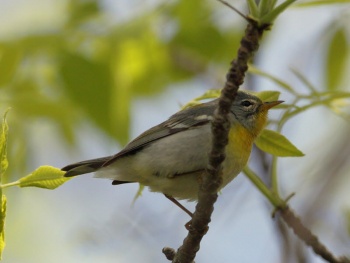(→Taxonomy: Update link) |
(Video link. References updated) |
||
| Line 1: | Line 1: | ||
| − | [[Image:Northern_Parula.jpg|thumb|550px|right|Photo by {{user|Paulyoly|Paulyoly}}<br/>Interlachen, [[Florida]].]] | + | [[Image:Northern_Parula.jpg|thumb|550px|right|Photo by {{user|Paulyoly|Paulyoly}}<br />Interlachen, [[Florida]].]] |
;[[: Category:Setophaga|Setophaga]] americana | ;[[: Category:Setophaga|Setophaga]] americana | ||
''Parula americana'' | ''Parula americana'' | ||
| Line 15: | Line 15: | ||
*Throat and chest yellow with blackish-slate and rufous band across upper chest<br /> | *Throat and chest yellow with blackish-slate and rufous band across upper chest<br /> | ||
'''Female''': duller | '''Female''': duller | ||
| + | [[Image:609-07297fg Female Northern Parula.jpg|thumb|350px|right|Female<br />Photo by {{user|bobsofpa|bobsofpa}}<br />Magee Marsh, [[Ohio]], [[USA]], May 2009]] | ||
==Distribution== | ==Distribution== | ||
Breeds in eastern [[North America]] (southern [[Canada]] to southern [[US]]). Migrating south to winter in east [[Mexico]], reaching to the [[Caribbean]] and [[Nicaragua]]. | Breeds in eastern [[North America]] (southern [[Canada]] to southern [[US]]). Migrating south to winter in east [[Mexico]], reaching to the [[Caribbean]] and [[Nicaragua]]. | ||
| − | |||
==Taxonomy== | ==Taxonomy== | ||
This is a [[Dictionary_M-O#M|monotypic]] species<sup>[[#References|[1]]]</sup>.<br /> | This is a [[Dictionary_M-O#M|monotypic]] species<sup>[[#References|[1]]]</sup>.<br /> | ||
| Line 28: | Line 28: | ||
It nest in trees in clumps of these mosses, laying 3-7 eggs in a scantily-lined cup nest. | It nest in trees in clumps of these mosses, laying 3-7 eggs in a scantily-lined cup nest. | ||
====Diet==== | ====Diet==== | ||
| + | [[Image:NOPA 1a Pin Pk 9 06 08.jpg|thumb|350px|right|Juvenile<br />Photo by {{user|DougLaslj|DougLaslj}}<br />Michigan, [[USA]], September 2008]] | ||
Diet includes insects and spiders. | Diet includes insects and spiders. | ||
====Vocalisation==== | ====Vocalisation==== | ||
'''Song''': a click-like ''trill'' or ''buzz, zeeeeee-yip''<br /> | '''Song''': a click-like ''trill'' or ''buzz, zeeeeee-yip''<br /> | ||
'''Call''': a soft ''chip'' | '''Call''': a soft ''chip'' | ||
| − | + | ||
==References== | ==References== | ||
| − | #{{Ref- | + | #{{Ref-Clements6thAug14}}#Avibase |
#USGS | #USGS | ||
{{ref}} | {{ref}} | ||
==External Links== | ==External Links== | ||
{{GSearch|Parula+americana}} | {{GSearch|Parula+americana}} | ||
| + | <br /> | ||
| + | {{Video|Northern_Parula}} | ||
[[Category:Birds]][[Category:Setophaga]] | [[Category:Birds]][[Category:Setophaga]] | ||
Revision as of 18:15, 21 August 2014
- Setophaga americana
Parula americana
Identification
4-4.3"
- Grey blue head and upperparts
- Black lores
- White eye-crescents
- Olive back patch
- 2 white wingbars
- White tail-spots
- White broken eye ring
- Yellow legs
- Throat and chest yellow with blackish-slate and rufous band across upper chest
Female: duller
Distribution
Breeds in eastern North America (southern Canada to southern US). Migrating south to winter in east Mexico, reaching to the Caribbean and Nicaragua.
Taxonomy
This is a monotypic species[1].
Formerly placed in genus Parula.
Habitat
Open woods; prefers woodlands with abundant tree lichens.
Behaviour
Breeding
It nest in trees in clumps of these mosses, laying 3-7 eggs in a scantily-lined cup nest.
Diet
Diet includes insects and spiders.
Vocalisation
Song: a click-like trill or buzz, zeeeeee-yip
Call: a soft chip
References
- Clements, J. F., T. S. Schulenberg, M. J. Iliff, D. Roberson, T. A. Fredericks, B. L. Sullivan, and C. L. Wood. 2014. The eBird/Clements checklist of birds of the world: Version 6.9., with updates to August 2014. Downloaded from http://www.birds.cornell.edu/clementschecklist/download/
- Avibase
- USGS
Recommended Citation
- BirdForum Opus contributors. (2024) Northern Parula. In: BirdForum, the forum for wild birds and birding. Retrieved 22 May 2024 from https://www.birdforum.net/opus/Northern_Parula
External Links






